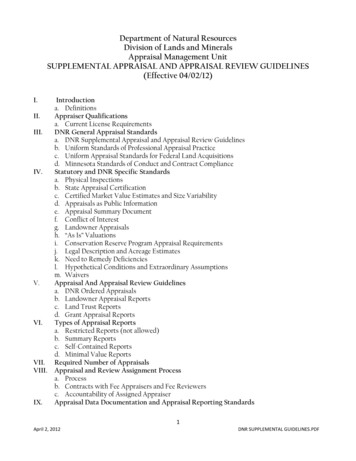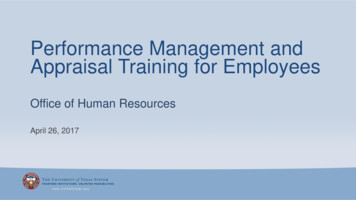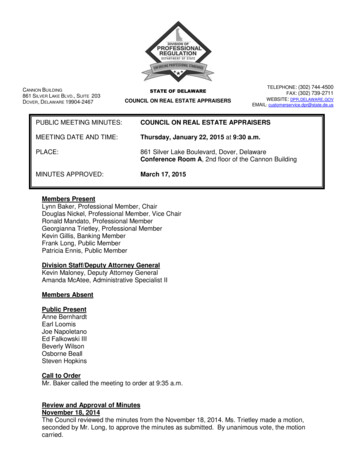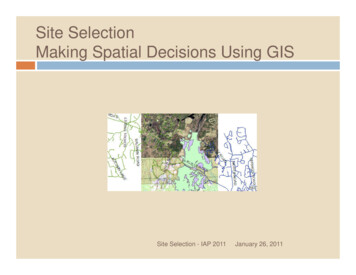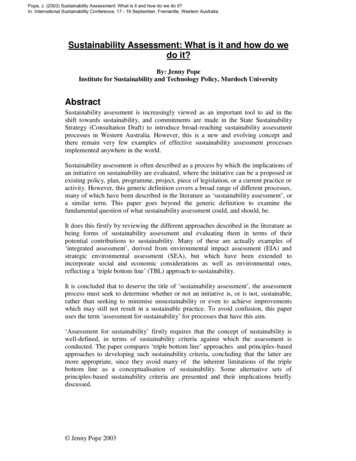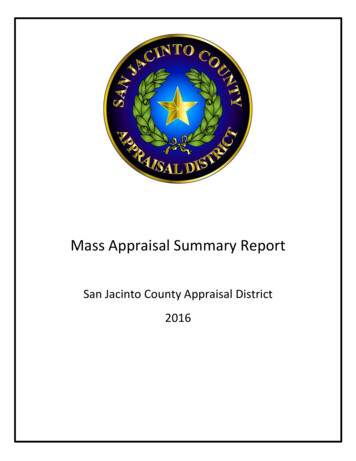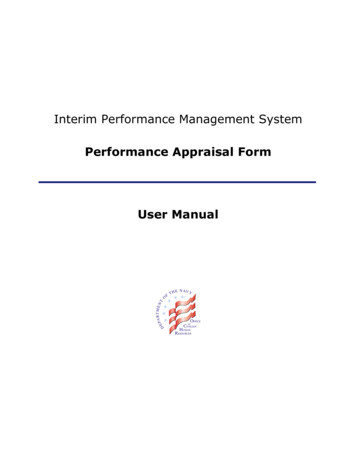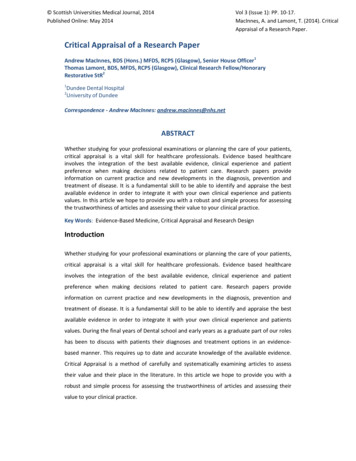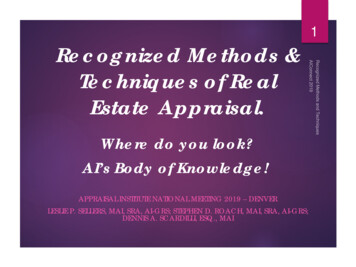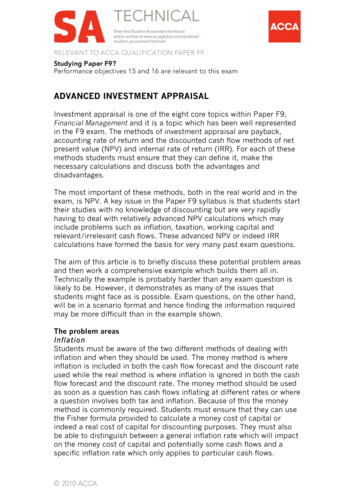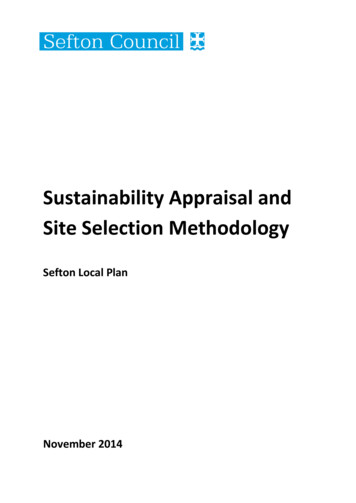
Transcription
Sustainability Appraisal andSite Selection MethodologySefton Local PlanNovember 2014
Contents1Introduction2Site Selection Methodology3Using the Methodology to Select AllocationsAppendix 1 - Local Plan Sustainability Objectives
1.Introduction1.1This report provides an overview of the methodology that has been used to selectdevelopment sites for the Publication Stage of the Sefton Local Plan. It builds on theassessment methodology used at Preferred Option Stage and provides a detailed frameworkfor assessing potential allocations for housing, employment, and gypsy and traveller pitches.1.2It also sets out a Sustainability Appraisal (SA) of potential development allocations, andincorporates the SA findings within a wider site selection methodology.Sustainability Appraisal1.3The Sustainability Appraisal is a systematic process that must be carried out during thepreparation of a Local Plan. Its role is to promote sustainable development by assessing theextent to which the Local Plan (and its allocations), when judged against reasonablealternatives, will help to achieve relevant environmental, economic and social objectives.1.4The draft Local Plan policies have also been subject to SA and this has been undertaken onthe Council’s behalf by environmental consultants URS. URS have also provided detailedinput into the methodology for the SA of potential Local Plan allocations.1.5For the purposes of selecting Local Plan allocations, SA criteria include:1. the accessibility of potential sites to services and facilities, and;2. an assessment of key environmental constraints.1.6In addition to these SA criteria (Appendix 1), other planning criteria are also relevant toselecting development sites. These include Green Belt purposes, other constraints (e.g.highways), and wider benefits that could be delivered by developing in a certain location.Both the SA criteria and other planning criteria are set out in Section 2.Sites in Green Belt1.7In order to meet “objectively assessed needs”, as requirement by national planning policy, aproportion of the Local Plan allocations for housing, employment and gypsy and travellersites will be on land currently in the Green Belt. Many of these sites have previously beenassessed and/or identified as a potential allocation at previous stages of the Local Planpreparation (‘Options’ and ‘Preferred Option’ stages). This assessment seeks to build on thework that has already taken place.1.8A draft Green Belt Study was published by the Council in 2011 to inform the preparation ofthe ‘Options’ stage of the Local Plan (then known as the ‘Core Strategy’). This study soughtto identify and assess ‘parcels’ of land in terms of their contribution to the 5 purposes ofincluding land in Green Belt, and the constraints that applied. It filtered out land that wasconsidered essential to remain in the Green Belt and land subject to severe constraints,1
leaving a ‘long list’ of areas for more detailed assessment. However, it did not allocate sites /land for development in the Local Plan.1.9Following the 2011 consultation and changes to national planning policy with theintroduction of the National Planning Policy Framework in March 2012, the Green Belt Studywas updated in 2013. This was used to inform a ‘Red, Amber Green’ assessment to identifythe sites identified as draft allocations in the ‘Preferred Option’ draft Local Plan (consultedupon during summer 2013).1.10This report builds on and updates the previous site selection methodologies in light ofconsultation responses, updated information (eg relating to Environment Agency floodzones and other evidence commissioned by the Council on behalf of site promoters) andadditional information received at ‘Preferred Option’ stage of Local Plan preparation andsubsequently, and best practice from elsewhere. A number of other sites were alsopromoted by landowners / developers as potential allocations at the ‘Preferred Option’consultation. For the purposes of transparency this assessment will review all sites that werepromoted to the Preferred Option consultation, as well as the potential allocations thatwere proposed at the Options stage.1.11It is considered that this approach has identified a long list of ‘reasonable alternatives’ for SA/ site allocation purposes.Structure of the Report1.12The remainder of the report is structured as follows:2. Site Selection Criteria – the factors that were used to assess in identifying potentialhousing, employment, and gypsy and traveller sites allocations3. Using the Methodology to Select Allocations – a summary of how the various factorswere be balanced in identifying site allocationsAppendix 1 – Links to Sefton’s Sustainability Objectives1.13In addition to the appraisal of strategic sites the Council has undertaken an appraisal of allthe potential sites in the urban area. These sites are assessed within the Strategic HousingLand Availability Assessment [SHLAA]. This is an assessment, updated annually, thatconsiders the capacity for additional homes in the urban area. This assessment considersaccessibility to a range of social infrastructure, flood risk issues, other constraints, suitabilityfor development and achievability. These assessments are made available online and thefindings of these help determine the amount of housing we can accommodate in the Seftonurban area, and therefore the shortfall that is require elsewhere. The assessments that makeup the SHLAA can be viewed at ngpolicy/evidence-and-studies/housing2
2.Site Selection Criteria2.1In order to identify potential Local Plan allocations a 5 part site selection methodology hasbeen devised, as set out below. Parts 1, 2 and 3a comprise the Sustainability Appraisal, andparts 3b, 4, and 5 comprise other planning considerations relevant to site selection.2.2The site selection methodology has been informed by Sefton’s Sustainability Objectives (seeAppendix 1), and other relevant planning and policy considerations. It is structured asfollows:Sustainability Appraisal (SA) criteria:1. Access to Services – an assessment of the proximity to nearby services2. Site specific / Wider Benefits - site specific benefits that could be provided, andwider benefits / needs that could be met3. Constraints to development – an assessment of the constraints affecting the site,including:a. SA constraints: that form part of the Sustainability AppraisalOther planning (non-SA) criteria:b. Other planning constraints: other constraints relevant to site selection4. Green Belt Purposes – an assessment of the contribution of the site to each of the 5purposes of including land in Green Belt (as set out at NPPF para 80)5. Delivery Considerations – an assessment of the deliverability of the site, includingowner intentions, viability, factors that could reduce net developable area, etc2.3Each of the 5 parts of the assessment are set in detail out below:Access to Services2.4Potential development sites were assessed against their proximity to key services andfacilities. This included proximity to: Train stations (employment, housing and gypsy and traveller sites)Bus stops (at a frequency of at least 2 services per hour - employment, housing andgypsy and traveller sites).District and Local centres, and shopping parades (housing and gypsy and travellersites)3
2.5Neighbourhood parks (housing and gypsy and traveller sites)GP surgeries /health centres (housing and gypsy and traveller sites)Primary schools (housing and gypsy and traveller sites)Site accessibility is expressed as the percentage of the site that is either of high, medium, orlow accessibility in terms of walking distance to the service / facility. The following ‘straightline’ accessibility distances were applied:HighMediumLowTrain Stations 800m 1,200m 1,200Bus stops (min. 2 services per hour) 400m 800m 800mDistrict / Local Centres / shopping parades 800m 1,200m 1,200mNeighbourhood Park 600m 900m 900mGP surgeries / health centres 800m 1,200m 1,200mPrimary School 800m 1,200m 1,200m2.6Sites were not selected or ruled out solely on accessibility grounds. Many accessibilitydeficits can be addressed, including through developer contributions and off-siteimprovements. In addition, potential development sites in Green Belt will inevitably belocated on the urban edge, and may therefore be less accessible than sites located withinurban areas.2.7There are a large number of services and facilities that could be used to score theaccessibility of a given site. However, for the purposes of site selection the assessment hasbeen restricted to those services and facilities that are considered to be the most importantand/or frequently used. Other possible accessibility criteria were considered and rejected,for the following reasons: Secondary schools: it is common for pupils to travel much further to secondaryschools than to primary schools (e.g. many Hightown and Ainsdale pupils attendFormby secondary schools). Many families also send their children to a more distantsecondary school out of choice. Town Centres: in Sefton, the two largest centres are Bootle and Southport towncentres. These centres contain a higher proportion of shops that sell items such aselectronics and clothing. This type of shopping is generally not represented to thesame extent in smaller centres, which tend to cater for local convenience needs.People are prepared to travel further to the larger centres, which are in any eventhighly accessible by public transport.4
Dentist surgeries: dentists surgeries are generally used less frequently than GPsurgeries and people are often prepared to travel further to use these services. Post Offices: these are generally located in existing town and local centres, whichare highly accessible by public transport Existing cycle routes: links to any nearby cycle route (if present) can be incorporatedinto and provided as part of any new development. Other services (e.g. leisure centres, libraries, etc): other services are typically lesswidely or less frequently used, and people are often prepared to travel further tothese.Site specific / wider benefits2.8The assessment also took into account the ability of potential allocations to deliver sitespecific or wider benefits to the local area. These included:2.9Site specific benefits:Will the site involve the redevelopment of brownfield land (Yes / No / Partially) Identified using aerial photographs and local knowledgeWould the development provide new or improved road / rail infrastructure? (Yes / No) Based on supporting information, local knowledge, and draft policy requirements.Would the site offer any other specific benefit? (Yes / No) 2.10Based on supporting information submitted and local knowledgeWider benefits / needsWill the site contribute towards the regeneration of a deprived area? (Yes / No / Partially) Based on the location of the site in either an identified regeneration area, or in anarea identified as being in the most 20% deprived of Super Output Areas nationally.Also dependent on the current condition of the site.Would the site create jobs in an area of high unemployment (employment allocations only Yes / No)5
Is the site in an area identified as being in the most 20% deprived of Super OutputAreas nationally?Would the site provide affordable housing in an area of high need? (Yes / No / partially) Sefton’s 2014 ‘Strategic Housing Market Assessment’ (SHMA) identifies affordablehousing need by settlement. This found there was a very high need for affordablehousing in Southport and Maghull/Lydiate/Aintree, and a high need in Crosby andFormby. Conversely, this study found a lower need for affordable housing in Bootleand Netherton.Would the site meet any other wider need or provide any other wider benefit? (Yes / No) Based on supporting information and local knowledgeConstraints to Development2.11Potential allocations were assessed against a series of typical development constraints.These constraints were divided into those that are relevant for the purposes of SustainabilityAppraisal, and other planning constraints that needed to be considered in site selection.2.12In addition, the constraints were divided into ‘Tier 1’ constraints (that could rule a site outregardless of other considerations) and ‘Tier 2’ constraints (that would not be of sufficientweight to rule a site out). The rationale for whether a site has been banded a ‘Tier 1’ or ‘Tier2’ constraint, and a description of how the constraint was assessed is set out below:Sustainability Appraisal Constraints:ConstraintTier Description‘Best and mostversatile’(BMV)agriculturalland2Ecology1What proportion of the land comprises ‘best and most versatile’agricultural land and the grade of land (where known). Informed bythe Agricultural Land Study or national dataA ‘tier 2’ constraint as there are insufficient non-BMV sites availablein suitable locations that are not subject to other constraints. BMVland can therefore be allocated for development consistent withNPPF para 112.Impact on protected habitats, species, and trees. Based oncomments provided by the Merseyside Environmental AdvisoryService’s (MEAS) and the findings of the HRA assessment.6
A ‘tier 1’ constraint as sites with high level ecological designationscould be ruled out.Flood Risk1Based on evidence from Sefton’s recent ‘Strategic Flood RiskAssessment (SFRA) and the latest Environment Agency’s flood riskdata. Includes an assessment of flood risk from all sources includingtidal, fluvial, surface water and groundwater flooding, assessedagainst the extent, severity and type of flood risk affecting the site.This constraint was also assessed in light of the Sequential andException tests where necessary.A ‘tier 1’ constraint as sites with a severe flood risk could be ruledout.Heritage1Impact on designated heritage assets and their settings, includinglisted buildings, Conservation Areas, Scheduled AncientMonuments, Historic Parks and Gardens, etc. Assessed by SeftonCouncil, taking account of submitted Heritage Assessments whereavailable.A ‘tier 1’ constraint as sites with major heritage impacts could beruled out.Pollution1Air quality, noise, vibrations, and light pollution. Includes proximityto Air Quality Management Areas (AQMAs), motorways / railways,landfill sites and proximity to other polluting and ‘bad neighbour’uses.A ‘tier 1’ constraint as severe cases could rule out development onpart or all of a site.Landscape2An assessment of the landscape sensitivity of the proposed site,and the impact on protected trees. This was informed by SeftonCouncil’s landscape appraisal.A ‘tier 2’ constraint, as there are no sites in Sefton that are subjectto either national or local landscape designations.Other Planning Constraints:ConstraintGroundTier Description2Presence of any known problematic ground conditions, including7
conditionspeat, land requiring deep piling, and contaminated land.A ‘tier 2’ constraint as can usually be mitigated through on-sitemeasures without adversely affecting viability.Site access1Whether safe and suitable access can be achieved to the site.Assessed by Sefton Council, taking account of submitted TransportAssessments where available.A ‘tier 1’ constraint as sites could be ruled out if a safe and suitableaccess cannot be provided.Highwaysnetworkcapacity1The impact of the development on the wider highway network,including roads / junctions with known capacity issues. Assessed bySefton Council, taking account of submitted Transport Assessmentswhere available.A ‘tier 1’ constraint as sites could be ruled where the impact onnetwork capacity is considered to be severe.Utilityinfrastructure2Whether the site can be serviced by gas, electricity, and water.Based on discussions with the major utility providers.A ‘tier 2’ constraint as can usually be mitigated through investment/ on-site improvements.ConstraintsOtherAny other constraint that may apply, e.g. airport flight path,proximity to a level crossing, right of way, hazards, etc.Tier of constraint depends on severity of particular constraint2.13Each constraint was graded by site against a 5 point scale, as follows. Tier 2 constraints werenever scored as either a ‘significant constraint’ or a ‘severe constraint’:No constraintondevelopment-No constraintMinorconstraint-A minor constraint that can be satisfactorily addressed withoutmitigation, or with limited mitigation.A constraint that only affects a small part of the site and can beaddressed without significantly reducing the amount ofdevelopment-8
Moderateconstraint-A constraint that requires more extensive / costly mitigation tosatisfactorily address, but that can be overcome.A constraint that affects a larger proportion of the site - requiringmitigation that would reduce the amount of development that canbe built, albeit it would not prevent development from taking place.-Significantconstraint(tier 1 only)-A significant constraint that requires very substantial / very costlymitigation to overcomeAlternatively, a constraint where it is not clear that it is capable ofbeing satisfactorily addressedA constraint that would very significantly reduce the proportion ofthe site that can be developed (e.g. less than half can be developed)-Severeconstraint(tier 1 only)-Constraint that cannot be overcome. Site cannot be allocated fordevelopment.Green Belt Purposes2.14Each site was assessed against its contribution to the 5 purposes of including land in GreenBelt (NPPF para 80). The severity of the impact was graded as follows: No impact on Green Belt purposeMinor impact on Green Belt purposeModerate impact on Green Belt purposeSignificant impact on Green Belt purposeSevere impact on Green Belt purpose2.15The severity of the impact on any Green Belt purposes was assessed by Sefton Council’sPlanning Department, based on professional judgement. A detailed explanation is set out foreach score.2.16Sites that were assessed as having a ‘severe impact’ on any Green Belt purpose were notallocated for development. In addition, the purpose “to assist urban regeneration” wasgraded as ‘unable to assess’ as it is not possible to assess this impact on a site by site basis.2.17The approach that was taken to each of the 5 purposes of including land in Green Belt is setout below:Green Belt PurposeHow will impact on the GB purpose be assessedTo check theunrestricted sprawl oflarge built-up areas How well contained are potential Green Belt sites by physicalboundaries? Do proposed sites breach an existing physical boundary tothe urban edge?9
What proportion of the site’s boundaries abuts an existing urban area?Do proposed sites ‘round off’ an existing urban area?To prevent townsmerging into oneanother To what extent does the site narrow any gap between towns? Howsevere is the impact on the existing gap?To assist insafeguarding thecountryside fromencroachment Open, ‘greenfield’ sites to be scored as “moderate impact on GreenBelt purpose”. Previously developed sites to be scored as “No impact on this GreenBelt use”No site was ruled out for development as a result of its existing use.To preserve thesetting and specialcharacter of historictownsNo site in Sefton had an impact on this Green Belt purpose, and hence allsites were assessed as having ‘no impact’.To assist urbanregeneration“Unable to assess” for all sites. It is not possible to assess this impact on asite by site basis.However, where a site would impact on heritage, (e.g. because there is alisted building, scheduled ancient monument or conservation area etc thatmay be impacted on as a result of development), this will be considered inthe “constraints” section of the assessment.Delivery Considerations2.182.19This section of the assessment comprised a record / assessment of: Owner intentions – does the owner wish to promote the site for development, andto what timescale? Any known viability issues Any known issues (including covenants) that would constrain or delay developmentThis section of the assessment was expressed as a commentary. If the owner of a site did notwish to promote it for development then it was not be allocated in the Local Plan.10
Site assessment conclusion2.20The final section of the assessment provided an overview of the site’s performance againsteach section of the assessment. This section indicated how these factors had been balancedand whether the site is proposed to be allocated for development.11
3.Using the Methodology to Select Allocations3.1The factors that were considered in assessing potential housing allocations are set outabove. The following principles were used to apply these criteria to select sites forallocation:3.2 Assessment of constraints: sites that are subject to any single ‘severe constraintthat cannot be overcome’ were not proposed for allocation. Sites that were subjectto any single ‘significant constraint’ were only allocated where this constraint can besatisfactorily addressed/mitigated through development. Access to services: the accessibility criteria will be used to highlight any potentialmitigation that may be required. No site was ruled out (or selected for allocation)solely due its accessibility to services. Green Belt purposes: sites that were judged to have a ‘severe impact’ on any GreenBelt purpose were not allocated for development. Sites that are judged to have a‘significant impact’ on any Green Belt purpose will only be allocated where there areinsufficient alternatives in the area that are not subject to any other majorconstraint. Delivery considerations: sites were ruled out where the owner is not interested inpromoting the site for development. Wider or site specific benefits: there are various benefits that individual sites maybe able to offer. In addition, there are wider needs within Sefton that only somesites will be able to address. For example, there is an acute need for affordablehousing in Southport (and elsewhere) that is specific to that settlement, and couldnot be met in other parts of Sefton. There are also distinct needs for employmentland in both north and south Sefton.Balancing these considerations in determining which sites should be allocated comes downin part to professional judgement. Whilst a proportion of sites were ruled out due to specificconstraints, or Green Belt impacts, a further planning judgement was required to selectwhich of the remaining sites were proposed to be allocated. This included weighing theimportance and magnitude of the various ‘scores’ for each site against the benefits thatcould be delivered. In coming to this judgement, some sites that can offer ‘wider or sitespecific benefits’ were allocated in preference to more accessible sites that do not offerthese benefits.12
Appendix 1 - Sefton’s Sustainability Appraisal ObjectivesThis appendix sets out how Sefton’s Sustainability Appraisal Objectives have been used as aframework for identifying appropriate site appraisal criteria. The Sustainability Appraisal objectiveswhich make up the SA Framework have been developed over a number of years following anassessment of the key sustainability issues in Sefton.The Sustainability Appraisal objectives were developed to appraise the Plan as a whole and thus arenot particularly suited for appraising the merits of individual sites. Nevertheless, the agreed list ofsustainability objectives provide an appropriate framework for determining what site selectioncriteria should be considered when assessing potential development sites for the Local Plan.The table below sets out the linkages between the SA Framework Sustainability Objectives and thecriteria which have been identified to assess potential site allocations:Sustainability ObjectiveSite selection criteria arising from the Objective1. Encourage economic growth andinvestmentCan the development provide or cross-subsidise theprovision of new employment land?SA Topics: Population, Material AssetsAll major residential, employment, and mixed usedevelopments will create jobs and investment. This is acommon benefit to all sites and cannot be used todistinguish between potential allocations.2. Reduce unemployment and improve skillsIs the site within a deprived area with high unemployment?(of particular relevance to employment sites)SA Topics: Population3. Support the rural economySA Topics: Population, Material AssetsWhat proportion of the site ‘best and most versatile’agricultural land? What proportion of the site is Grade, 1,2, or 3a?4. Maintain vibrant town, local and villagecentresIs the site within walking distance to local and districtcentres and shopping parades?SA Topics: Population, Material Assets,Cultural Assets5. Provide the required infrastructure tosupport growthCan the site be satisfactorily accessed?SA Topics: Population, Material AssetsIs there sufficient capacity in the highways network toaccommodate the development?6. Reduce inequalities and socialdeprivationWould development of the site Contribution towardsregeneration?SA Topics: Population, Human HealthWould an employment allocation create jobs in an area ofhigh unemployment?7. Reduce crime and improve safetyNeutral impact for all sites, and therefore notdistinguishable for site selection purposes13
Sustainability ObjectiveSite selection criteria arising from the ObjectiveSA Topics: Population, Human Health8. Meet Sefton’s diverse housing needsSA Topics: Population, Material Assets,Human Health9. Provide better access to services andfacilities, particularly by walking, cyclingand public transportWill the development help to meet local affordable housing,or other specialist housing needs?Is the site accessible to schools, services, and publictransport?SA Topics: Population, Human Health,Material Assets, Air, Climatic Factors10. Provide environments that improvehealth and social careSA Topics: Population, Human Health,Material Assets11. Strengthen communities and helppeople to be involved in local-decisionmakingIs the site accessible to open space?Is the site of ecological value?Does the site contain a right of way?Neutral impact for all sites, and therefore notdistinguishable for site selection purposesSA Topics: Population12. Adapt and mitigate to climate changeIs the site subject to flood risk?SA Topics: Climatic Factors, Biodiversity,Fauna, Flora, Soil, Water, AirIs the site accessible to public transport?13. Reduce the risk from floodingIs the site subject to flood risk?SA Topics: Climatic factors, Human Health,Material Assets, water14. Reduce pollutionSA Topics: Biodiversity, Fauna, Flora,Human Health, Soil, Water, Air15. Reduce waste and the use of naturalresourcesIs the site potentially subject to contamination or otherground condition issues?Is the site of ecological value?Neutral impact for all sites, and therefore notdistinguishable for site selection purposesSA Topics: Climatic Factors, Material Assets16. Protect Sefton’s valued landscape, coastand countrysideIs the site subject to any landscape or other sensitivedesignation?SA Topics: Biodiversity Fauna, Flora,Material Assets, Cultural Heritage,LandscapeWould the development affect any protected trees?17. Bring back into use derelict andunderused land and buildingsWould the development re-use previously developed land?14
Sustainability ObjectiveSite selection criteria arising from the ObjectiveSA Topics: Material Assets18. Protect and enhance biodiversityIs the site of ecological value?SA Topics: Biodiversity, Fauna, Flora19. Protect and enhance Sefton’s cultureand heritageSA Topics: Cultural Heritage, MaterialAssets20. Provide a quality living environmentSA Topics: Population21. Land ResourcesWould the development have an impact on a designatedheritage asset, or the setting of a designated heritageasset?Neutral impact for all sites, and therefore notdistinguishable for site selection purposesWould the development re-use previously developed land?SA Topics: Material Assets, CulturalHeritage, soil15
2. Site Selection Criteria 2.1 In order to identify potential Local Plan allocations a 5 part site selection methodology has been devised, as set out below. Parts 1, 2 and 3a comprise the Sustainability Appraisal, and parts 3b, 4, and 5 comprise other planning considerations relevant to site selection.
